Thinking about adding a solar panel patio cover but unsure where to start—or how much it really costs? You’re not alone. A solar patio cover combines shade, comfort, and clean power generation in one structure, but the best way to build it depends on your existing setup, materials, and budget.
In this guide, you’ll learn what a solar patio cover is, how to upgrade an existing patio with solar panels, and the main options for building one—from DIY projects to factory-engineered steel kits. We’ll also compare materials like wood, aluminum, and galvanized steel, outline key steps for construction and installation, and break down cost ranges so you know what to expect before you start.
Finally, we’ll show how modern solar patio covers can be both durable and stylish, and how partnering with an experienced manufacturer like SteelPRO PEB—a certified PEB & Steel Structures Producer—ensures safety, precision, and long-term performance from factory to foundation.
Ready to plan your own? Let’s explore what it takes to build a solar patio cover that’s efficient, affordable, and built to last.
What Is a Solar Panel Patio Cover and Why Consider One?
A solar panel patio cover is a structure that gives you shade and produces electricity. It’s like a regular patio cover—but with solar panels on top. This way, you make better use of your outdoor space while lowering your energy bills.
Many homeowners are choosing solar patio covers because they combine comfort, functionality, and sustainability. You get a cooler sitting area, and at the same time, your patio becomes a small power station for your home.
If you already enjoy spending time in your backyard or on your patio, this is a smart upgrade. And if you’re planning a new build, starting with a solar-ready design saves time and money down the road.
Besides energy savings, a well-built solar patio cover can:
- Increase your home’s resale value
- Help reduce your carbon footprint
- Give you more control over your energy use
In short, it’s a way to turn your everyday outdoor space into something smarter—with real, long-term value.
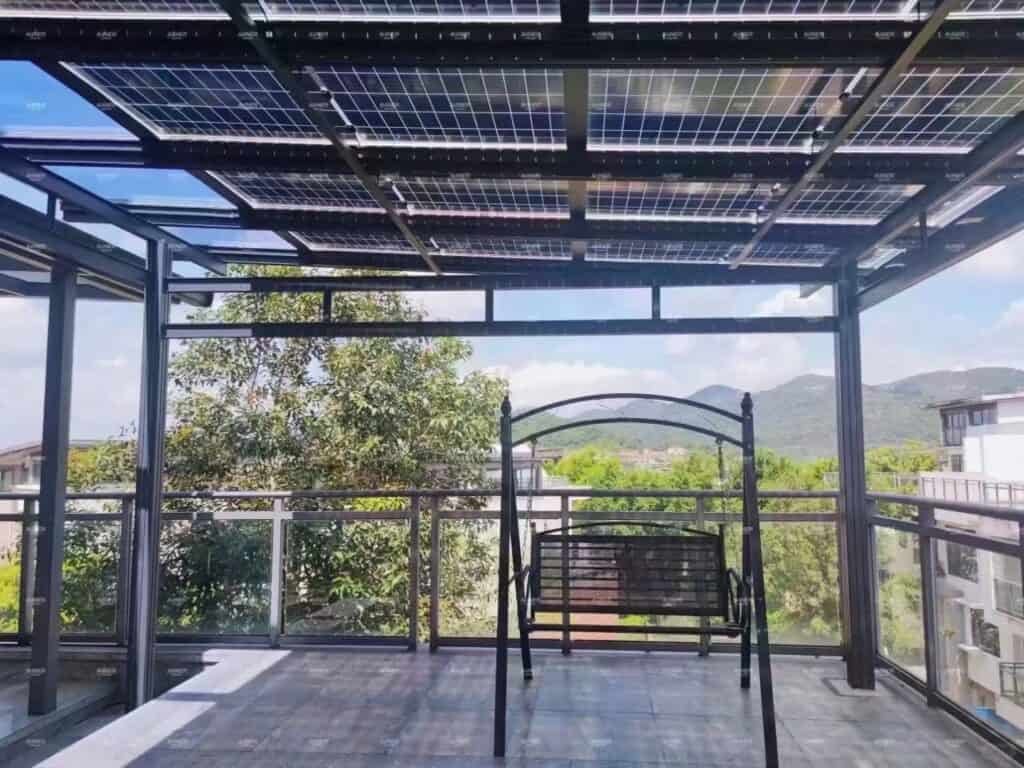
Can I Install Solar Panels on My Existing Patio Cover?
Yes, you can often install solar panels on your current patio cover, but it takes the right reinforcements and materials to do it safely and efficiently.
How to Check if It’s Suitable
Is it strong enough?
Solar panels aren’t extremely heavy, but your structure must be load-bearing. Lightweight wood or aluminum frames may not safely support the panels—especially in areas with strong wind or snow.
Does it get enough sun?
Orientation matters. South-facing covers work best. If your patio is mostly in the shade or faces the wrong direction, the energy output may not be worth the cost.
What’s the roof surface like?
Solid flat or gently sloped surfaces are easier to mount on. Decorative or open-lattice designs may need custom mounting brackets or a full roof reinforcement.
Retrofit Options for Existing Patio Covers
If your patio passes the basic checks, great—you may only need a mounting system and a licensed solar installer.
If not, there are still reliable ways to upgrade your structure for solar integration.
- Add Structural Reinforcement: Strengthen existing beams with steel or aluminum support channels, or add vertical posts under high-load areas. This prevents deflection and improves long-term stability.
- Replace the Roof Section: Swap lightweight panels or wood sheets with corrugated steel roofing or solar-ready composite decking, which can directly hold solar racking rails.
- Hybrid Framing Retrofit Kits: Some manufacturers, including SteelPRO PEB, provide solar-ready retrofit kits — prefabricated steel support frames and beam reinforcements designed to attach to existing patios. These kits allow homeowners to upgrade wooden or aluminum covers into fully solar-compatible structures without a complete rebuild.
- Full Frame Replacement (if needed): For older or weak structures, replacing the top frame with a pre-engineered steel canopy is often safer and more efficient than trying to reinforce outdated materials.
Cost and Practical Considerations
Retrofits are typically 30–50% cheaper than building a brand-new solar patio cover, depending on the condition of the existing structure. Before starting, have a structural engineer or supplier evaluate the frame’s capacity and anchoring system. Reinforcing early can save thousands in the long run by preventing structural fatigue or solar misalignment.
Expert Help When You Need It
If you’re unsure whether your existing patio cover can handle solar panels, reach out to SteelPRO PEB, a certified PEB & Steel Structures Manufacturer. We offer solar-ready steel retrofit systems that integrate directly with existing patios — engineered for strength, wind resistance, and long-term durability.
What Are the Options for Building a Solar Patio Cover?
If you’ve decided to build a solar-ready patio cover, there are three main paths you can take. Each one works—you just need to find the right fit for your budget, skills, and timeline.
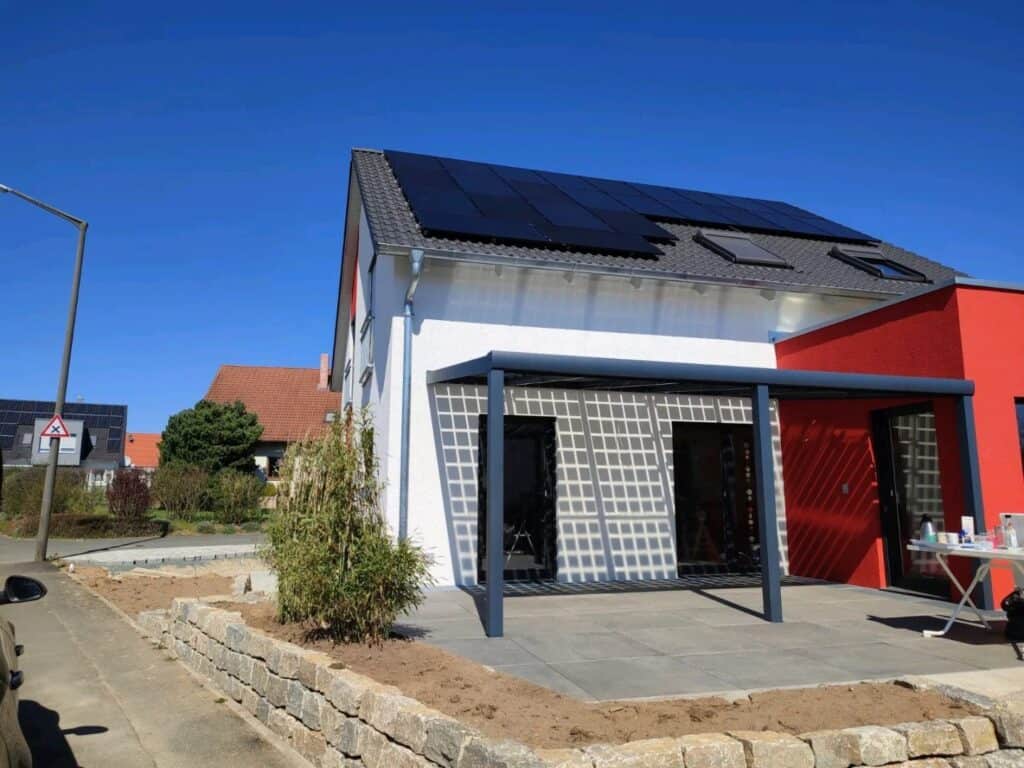
1. Build It Yourself (Custom DIY Approach)
This option gives you full control. You design the structure, choose materials, and handle the installation.
It’s best if you’re experienced with building projects or working with a contractor you trust.
Pros:
- Total freedom in design
- Can be cost-effective if you have the tools and time
Keep in mind:
You’ll need to make sure the structure is strong enough to support solar panels. Engineering help may be required, especially for steel or hybrid frames.
2. Use a Pre-Engineered Solar Patio Kit
These kits come with everything pre-cut and pre-drilled. They’re made to carry solar panels and are often modular in design.
This is ideal if you want something easier and faster to assemble.
Pros:
- Faster installation
- Less design guesswork
- Often more reliable structurally
Keep in mind:
Make sure the kit matches your local building codes and solar needs. Some kits may look simple but aren’t built for long-term performance.
Enhanced Option – Factory-Engineered Steel Kits
Factory-produced solar patio cover kits — such as those from SteelPRO PEB, a certified PEB & Steel Structures Manufacturer — are designed for both strength and simplicity. Each system includes pre-drilled and pre-cut steel beams, columns, roof supports, and connection parts, ensuring precision fit and quick assembly on-site.
Available in common module sizes (e.g., 5x10m, 5x20m) or fully customized dimensions, these structures are engineered for solar integration, certified for wind and snow loads, and treated with hot-dip galvanization or powder coating for long-term outdoor durability.
Compared with a DIY wood build, factory-engineered steel kits:
- Provide certified load-bearing strength
- Require minimal on-site cutting or welding
- Offer clean alignment for solar panel mounting
- Come with optional installation manuals and remote guidance
In short, a pre-engineered solar patio kit gives you a faster, safer path to installation — combining professional design with the convenience of modular assembly.
3. Order a Custom Steel Structure from a Supplier
This is a smart option if you want something engineered for solar and built to last. Companies like SteelPRO PEB offer steel patio frames tailored to your space, load requirements, and solar layout.
Pros:
- Durable, weather-resistant, solar-ready
- Engineered for your location
- Can be shipped as a ready-to-assemble system
Keep in mind:
This option may cost more upfront than DIY wood builds—but it often saves time and avoids problems later.
No matter which path you choose, the goal is the same: a safe, functional, and solar-compatible patio cover. If you’re not sure which option fits you best, we’re always happy to help you compare and decide.
What Materials Work Best for the Structure?
Choosing the right material for your solar patio frame isn’t just about looks. It affects how long the structure will last, how much weight it can carry, and how much work it needs over time.
Wood is a popular choice for its natural look. It blends well with most home styles and can be customized easily. But it comes with downsides—wood needs regular maintenance, can warp or crack over time, and often isn’t strong enough for solar loads without reinforcement. If you live in a humid or termite-prone area, it may not hold up well in the long run.
Steel is known for its strength and durability. It’s ideal for supporting solar panels, especially in larger setups or in areas with wind or snow. Modern steel structures are corrosion-resistant and can be powder-coated for better aesthetics. They require very little maintenance and are designed to last decades, making them a solid long-term investment.
Aluminum is lightweight and doesn’t rust, which makes it a good option in coastal or wet climates. However, it’s not as strong as steel. In most cases, aluminum frames need extra bracing if used to support solar panels. For small structures, it can work—but for anything more substantial, steel is often the better choice.
To make things clearer, here’s a quick comparison:
| Material | Strength | Lifespan | Maintenance | Solar Suitability |
| Wood | Medium | 10–15 years | High | Needs reinforcement |
| Steel | High | 25+ years | Low | Excellent |
| Aluminum | Low–Medium | 15–20 years | Low | Limited |
If your goal is a structure that supports solar panels safely and lasts for years with minimal upkeep, steel often gives you the best balance.
How Do You Actually Build a Solar Panel Patio Cover?
Building a solar patio cover may sound complex—but when you break it down, it follows a clear set of steps. Whether you’re doing it yourself or hiring help, here’s how the process usually works:
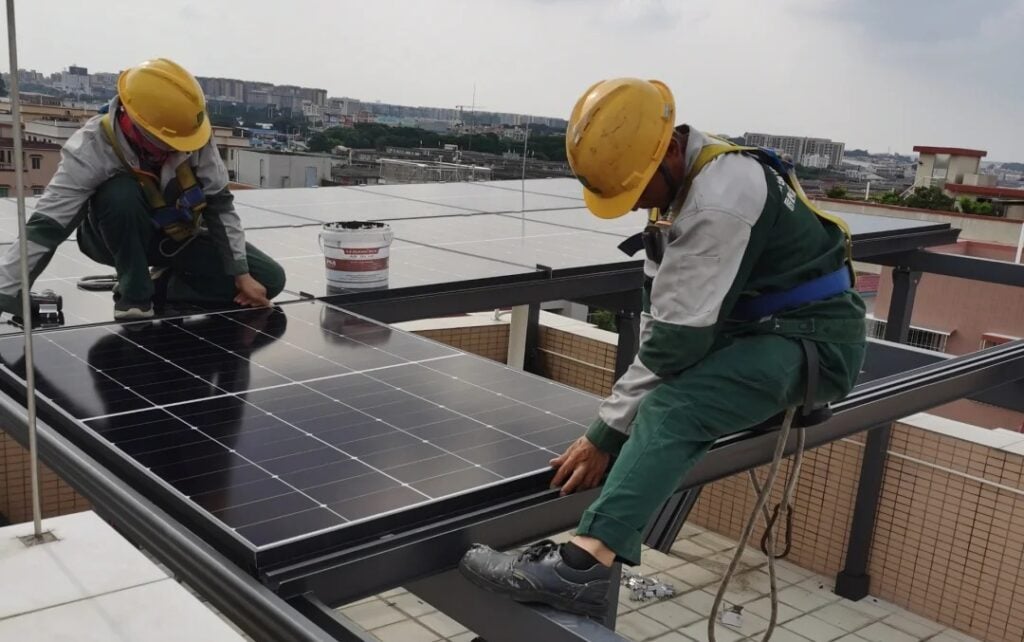
1. Plan Your Layout
Start by deciding where your patio cover will go. Look at how the sun moves across your property and make sure the area gets enough sunlight.
Measure the space and think about how big you want the cover to be—5x10m or 5x20m modules are common for steel structures.
If you’re planning to connect it to an existing wall, check the wall’s integrity and make sure it can bear additional load.
South-facing layouts (in the Northern Hemisphere) maximize solar generation. Avoid shaded areas caused by trees, walls, or nearby roofs.
2. Choose or Design the Structure
Pick a frame that fits your space and solar needs. You can use a standard pre-engineered steel kit or design your own from scratch.
If you’re using a factory-supplied system, ensure it’s pre-drilled and pre-cut for quick bolt assembly.
Most modern frames use hot-dip galvanized (HDG) steel beams joined by high-strength bolts and cross braces, allowing accurate alignment for solar mounting rails.
Always confirm that the steel sections meet your area’s wind and snow load standards (ASCE 7, Eurocode, or GB50017).
3. Prepare the Foundation
A solid foundation ensures the entire structure’s stability.
Depending on your setup, this may involve concrete footings or ground anchors.
If using concrete, allow sufficient curing time (typically 5–7 days) before loading the frame.
For portable or light structures, bolt-down anchors can be used on existing concrete slabs.
4. Assemble the Frame
This is where your planning pays off.
Follow the design drawings or kit instructions closely. Start with upright columns, then connect main beams and rafters using the provided pre-drilled holes.
Use a leveling laser or string alignment to maintain consistent height and spacing.
Tighten all bolts to manufacturer-specified torque levels to ensure proper structural tension.
For steel kits from manufacturers like SteelPRO PEB:
Each component is pre-numbered and labeled for simple, step-by-step installation, minimizing on-site cutting or welding.
5. Install the Solar Panels
Once the frame is complete and level, mount the solar panels on top using the designated brackets or rail system.
The tilt angle should match your latitude for optimal efficiency (usually between 15°–30°).
Ensure waterproof sealing around all junction points and cable routing paths.
All electrical wiring and inverter connections should be handled by a licensed solar installer for safety and compliance.
6. Final Checks and Maintenance
After installation, inspect all structural joints, panel fasteners, and grounding lines.
Clean the panels regularly and inspect the steel surface annually for paint wear or corrosion.
Properly maintained, a steel solar patio cover can last 25+ years with minimal upkeep.
In short:
The process is manageable if you plan carefully and use a well-engineered frame. A pre-drilled, factory-ready kit not only simplifies the build but also ensures long-term safety and alignment for your solar panels.
How Much Does a Solar Patio Cover Cost?
There’s no single price tag for a solar patio cover. The total cost depends on several factors, including the structure, the solar system, and the installation method. But with a bit of planning, it’s easier than you think to find an option that fits your budget.
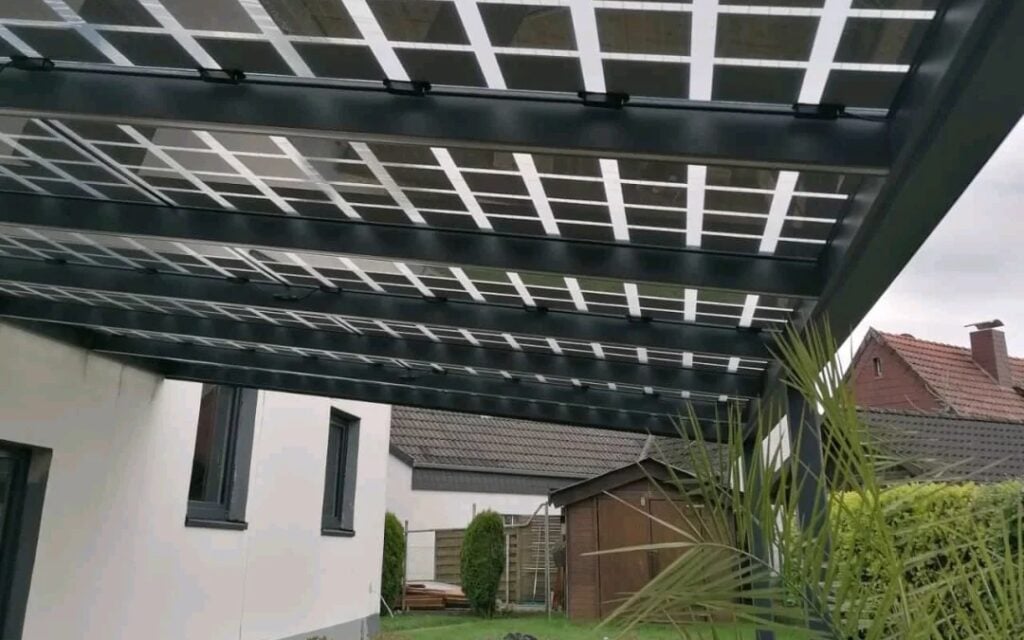
What affects the total cost?
Here are the main elements that shape the final price:
- Structure type and materials
Steel frames cost more upfront than wood, but they last longer and need less upkeep. - Size and complexity
A simple 2-post cover costs less than a custom L-shaped design or a large freestanding unit. - Solar panel system
Costs vary based on panel efficiency, number of panels, and power output. - Labor and permits
If you hire a contractor or need engineering approvals, that adds to the budget.
Cost Breakdown by Type
| Setup Type | Description | Estimated Cost (USD) | Ideal For |
| DIY Wood or Aluminum Frame + Panels | Simple patio retrofit using basic materials; limited load capacity and lifespan. | $4,000 – $8,000 | Homeowners on tight budgets |
| Pre-Engineered Steel Patio Cover Kit + Panels | Factory-produced modular system (e.g., from SteelPRO PEB) — includes pre-drilled beams and connectors, ready for assembly. | $9,000 – $15,000+ | Mid-range residential or small commercial projects |
| Custom Steel Structure + Integrated Solar System | Fully engineered structure with site-specific design, local load certification, and optional on-site support. | $12,000 – $20,000+ | Premium or large-scale applications |
Why Factory-Supplied Systems Often Save More
While a custom steel structure may cost more initially, factory-engineered kits reduce both labor hours and rework costs. Because the parts are pre-cut, coated, and tested before shipping, you save time on construction and avoid hidden installation expenses. For commercial projects, these systems can also qualify for solar tax incentives and long-term structural warranties.
Is It Worth the Investment?
Many homeowners find that a solar patio cover pays for itself over time. By generating your own electricity, you lower your monthly bills. In sunny areas, the payback period can be as short as 6–8 years, depending on your usage. Plus, it’s not just about savings—it’s also an upgrade to your home’s value and comfort.
The key is to balance your goals, your budget, and the long-term return. Whether you go simple or custom, there’s a solution that can work for you.
Related Reading: Are Solar Patio Covers Worth It? Here’s the Real Answer
Want exact pricing for your setup?
Contact SteelPRO PEB — a certified PEB & Steel Structures Manufacturer — to get a factory-direct solar patio cover quote tailored to your site and energy goals.
Do I Need a Permit or Professional Help?
If you’re thinking about building a solar patio cover, this is one question you shouldn’t skip. It may not be the most exciting part—but it can make or break your project.
Permits: Do You Need One?
In many areas, yes. Even if your structure seems simple, adding solar panels means extra weight and electrical components. That usually triggers the need for a building permit, especially if the frame is attached to your home.
Local rules vary, so it’s always best to check with your city or county office before starting. They may ask for structural drawings, load calculations, or stamped documents.
Should You Hire a Professional?
That depends on your setup and your experience. Here’s a simple way to think about it:
- If you’re building a small, freestanding wooden structure and using plug-in solar kits, you might handle it yourself.
- But if you’re working with steel, mounting high-wattage panels, or connecting to your home’s grid, you’ll likely need a licensed contractor—especially for electrical work.
Also, don’t overlook the value of an engineer or structural supplier who understands local codes. They can make sure your design is not just strong—but also compliant.
Can Solar Patio Cover Be Stylish Too?
Absolutely. Just because it’s solar doesn’t mean it has to look industrial. A well-designed solar patio cover can be both functional and beautiful—something that complements your outdoor space, not clashes with it.
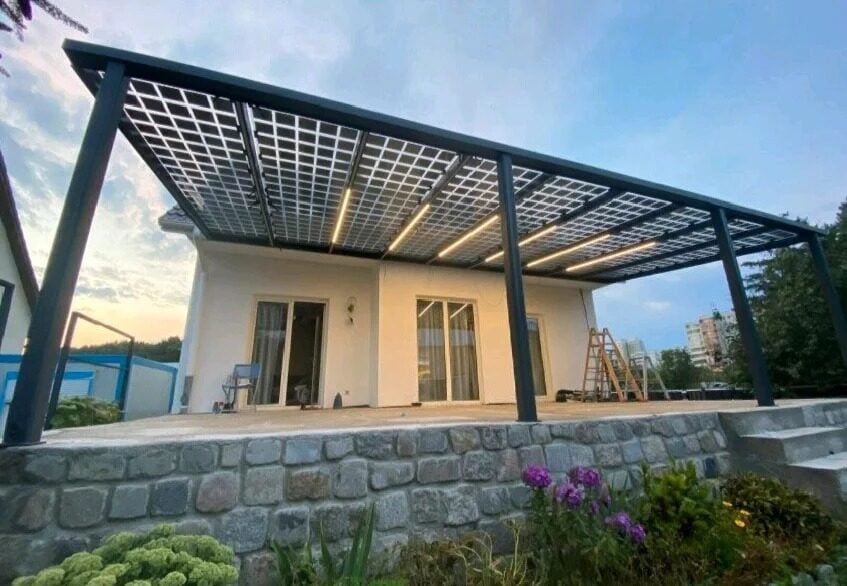
Think clean steel lines paired with wood accents. Or a minimalist flat roof that matches your modern home. Some designs look like high-end pergolas, with hidden wiring and sleek solar panels that blend right into the roofline.
You can also add finishing touches:
- Powder-coated surfaces in colors that match your home
- Built-in LED lighting
- Decorative beam profiles or panel trims
If you start with the right structure, style becomes part of the build—not just an afterthought. Steel, for example, can be both strong and visually elegant. It offers clean geometry, slim profiles, and plenty of room for creative expression.
At SteelPRO PEB, we’ve seen clients turn simple solar covers into design highlights. If you have a vision in mind, chances are we can help bring it to life.
Can I install solar panels on an existing patio roof?
Yes, but only if the structure can safely carry the additional load. Wood or aluminum roofs may need steel reinforcements or retrofit kits to meet solar standards. Many homeowners use SteelPRO PEB’s solar-ready retrofit frames, which strengthen existing covers for long-term stability.
How much does a solar patio cover cost on average?
Prices typically range from $9,000–$15,000 for pre-engineered steel kits and $12,000–$20,000 for custom structures. Final cost depends on materials, size, and installation. For accurate pricing, you can request a factory-direct quote from SteelPRO PEB.
Are steel solar patio covers certified for wind and snow loads?
Yes. High-quality structures follow international standards such as ASCE 7, Eurocode 3, and GB50017, ensuring safety and load-bearing integrity even under extreme conditions.
Are solar patio covers really worth it?
Absolutely. They generate clean energy, cut electricity bills, and add property value. In sunny climates, most systems pay for themselves within 6–8 years while providing shade and comfort year-round.
Do these covers come with installation support?
Yes. Most steel kits include detailed manuals and video guides. SteelPRO PEB also offers remote installation assistance and optional on-site supervision for large projects.
Where Can I Find a Trusted Structure Supplier?
Choosing the right supplier is one of the most important steps in building a safe and long-lasting solar patio cover. Many homeowners struggle to find a balance between strength, design accuracy, and installation support—especially when upgrading from wood or light aluminum structures.
That’s where SteelPRO PEB stands out. As a certified manufacturer of solar-ready steel and PEB structures, SteelPRO PEB designs every frame to handle solar load, wind resistance, and corrosion challenges in outdoor environments. Our in-house production lines use CNC laser cutting, robotic welding, and hot-dip galvanization, ensuring precise joints and long-term durability.
Beyond manufacturing, we provide 2D/3D design previews, international certification (ISO, CE), and remote installation guidance, giving you full confidence from planning to assembly. Whether you need a custom retrofit solution or a factory-engineered solar patio cover kit, SteelPRO PEB delivers complete systems ready for solar integration directly from the factory, without middlemen.
Learn more about their engineered solutions here: Solar Patio Cover

